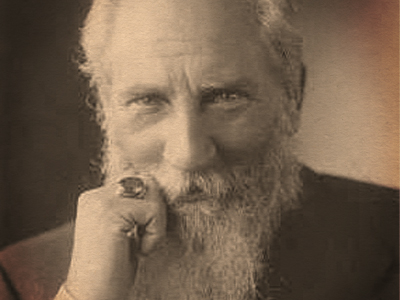
Charles Webster Leadbeater
Charles Leadbeater was born in Northumberland in 1854. It is also believed to be born in Stockport, Cheshire, England. The England Censuses of 1861 confirm that year. However, beginning in the early 1880’s, Leadbeater gave his birth year as 1847. That date appeared in the 1891 census and other records. 1847, is the same year that his close associate Annie Besant was born. According to C. Jinarajadasa, the Leadbeater family was Norman French in origin, with name Le Batre, later Englished to Leadbeater. His father was an engineer and director of a railway construction company. Through his family were orthodox Christians, they were interested in occult phenomena. As a young child, Leadbeater was deeply impressed when Bulwer Lytton, visiting his home, made a letter appear and move across the room.
At age thirteen, his family went to Brazil where his father oversaw construction of a railroad to the interior. One day, when Leadbeater and his younger brother accompanied the work crew to the site, they were attacked by hostile tribesmen, and his brother was killed. His father died a few years later, in 1862. On return to England, family financial reverses prohibited young Charles from entering Oxford University. Instead, he worked as a bank clerk for two years, and then in 1879, following the footsteps of his uncle, he became a clergyman of the Church of England. He served as a curate in Bramshott. In 1883, read a copy of A.P. Sinnett’s book The Occult World, and became interested in Theosophy. He met the author and joined the London Lodge.
In 1884, he met Madame Helena Blavatsky, and investigating Spiritualistic phenomena with another theosophist William Eglinton. his devotion to the Adept Brotherhood led him to write a letter to the Master Koot Hoomi, stating his desire to become his pupil. After some months two letters were received in reply. A few days Leadbeater was on ship, in the party of Madame Blavatsky, bound for India where he met Colonel Olcott, and A. J. Cooper-Oakly. Leadbeater, in 1885 began to serve the Theosophical Society in several official capacities. At the same time his Master directed him in techniques to develop clairvoyance. He there by gained the ability to maintain continuous astral consciousness whether asleep or awake. From that time, he began occult investigations, and through the years wrote many books on the results of his studies. When Olcott founded Ananda College in Colombo, Ceylon (now Sri Lanka), in 1886 installed Leadbeater as the first principal. While in Ceylon as General Secretary of the Theosophical Society from 1888-1889.
In December 1889, he, and C. Jinarajadasa left Ceylon for England, where C.J. became a student at S. John’s College, Cambridge, while Leadbeater earned their living as a tutor. In 1895, he made his home at the theosophical headquarters in London, and began lecture tours to Europe, America, Australia, and New Zealand. In 1906, trouble arose over his alleged immoral teachings to young boys. Though maintaining he had done no wrong, he resigned membership in the Theosophical Society to preserve the Society from blame. In 1908, the General Council invited him to return, and he was reinstated. Unfortunate publicity of the situation continued for many years. Annie Besant, the International President, invited Leadbeater to make his home at Adyar (Chennai). In 1909, discovered the young boy, J. Krishnamurti, on the Adyar beach. Leadbeater was so struck with his extraordinarily pure aura that he chose him to be the vehicle for the coming World Teacher. Mrs. Besant became the guardian of Krishnamurti and his younger brother, Nityananda, and Leadbeater began their training.
In 1913, Leadbeater went to Australia, for several years, lecturing and writing. He worked in Co-Masonry, and in 1916 was consecrated Bishop in the Liberal Catholic Church. He became Head of the Manor, a large theosophical home, in Sydney in 1922. Throughout these years, he kept in close touch with Mrs. Besant and Krishnamurti. In 1925, he returned to Adyar at Mrs. Besant’s request. Though a heart condition limited his activities, he undertook extensive lecture tours in Europe. He was with Dr. Besant in 1933 during her last illness. At her death, he became her successor as Head of the Esoteric Section. He left India in January 1934 for Sydney, Australia, but on-board ship became too ill to continue. At Perth, he was removed to a hospital where he died on March 1.
